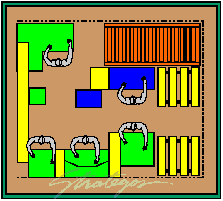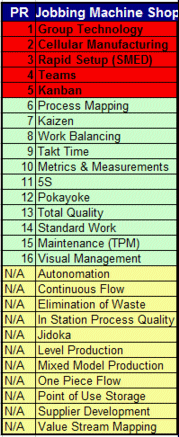Job Shop Lean
Are Job Shops Really Different?
Lean and the Job Shop
Lean Manufacturing in job shop environments has an uneven record. There are some notable successes, some disasters and many non-starters. We can add misguided perceptions about Lean's applicability to the usual culprits of non-support and change resistance.
-
In some cases managers view Lean as a universal theory for all situations. Since much of the lean literature derives from Toyota, they attempt to copy Toyota's practices without question. In a job shop this can lead to disaster (See Blitzing To Disaster). At best this means a lot of work with little result.
-
In other cases, managers recognize that "job shops are different" and then conclude that Toyota's methods have no place in a job shop. Hence, the non-starters.
Actual situations are more complex and more subtle. At Strategos, we see differences in the following areas:
|
Cellular Manufacturing
 Workcells
in a job shop are quite different than in a higher production facility. They may process
hundreds of different (although somewhat similar) items rather than the 3-4 items typical in
higher production facilities. The demand for the various items may vary considerably both
in pattern and overall volume. The process may vary significantly both in the routings and in
tools and fixtures. Work times, setup times and lot sizes vary over a wide range.
Workcells
in a job shop are quite different than in a higher production facility. They may process
hundreds of different (although somewhat similar) items rather than the 3-4 items typical in
higher production facilities. The demand for the various items may vary considerably both
in pattern and overall volume. The process may vary significantly both in the routings and in
tools and fixtures. Work times, setup times and lot sizes vary over a wide range.
Job shop workcells sometimes appear similar to high production Toyota-type cells but they function differently. One Piece Flow may not be applicable and internal lot sizes may be larger. The matching of product groups to workcells becomes difficult. Several jobs may be in process simultaneously within the cell. Quality approaches are often substantially different with more emphasis on operator knowledge and Attribute Charts rather than mistake-proofing and Variables Control Charts.
All of this requires a far more rigorous design process based on fundamentals rather than cookbook formulae. Our pages on Workcell Design can help.
|
GT Part Family |
Group Technology (GT) is the art and science of grouping items according to similarities in relevant characteristics. Generally in manufacturing, this means similar characteristics in process routings and sequences. Such grouping is one of the first steps in a rigorous cell design process. It defines what parts go in which cells.
In high-volume, low-variety production, part groups are often self-evident. At most some discussion and informal thought may be necessary. However, many job shops cope with thousands of parts and dozens or hundreds of workcenters. Intuitive and informal methods are insufficient for these situations.
Production Flow Analysis (PFA) or Coding and Classification (C&C) are often necessary. The Lean literature sometimes presents simple examples of PFA but these examples are rarely practical and rarely involve more than a dozen products. Real-life situations are more difficult and complex. For an example of a real PFA chart developed for an electronics job shop, click here. Software such as PFAST may also be useful.
Kanban & Scheduling
 Kanban
has limited application for many job shops. The volumes are too low and demand too erratic.
However, there may be opportunities for certain items and careful analysis is prudent.
Kanban
has limited application for many job shops. The volumes are too low and demand too erratic.
However, there may be opportunities for certain items and careful analysis is prudent.
In addition there may be opportunities to use kanban with purchased parts, hardware items, accessories or items that are common to multiple products. Kanban and MRP type scheduling can even co-exist in the same workcell. When deciding on kanban, variability of demand is more important than overall volume. For example, the demand for an item may be only 2-3 parts per week, but if it is always 2-3 parts per week, kanban is effective.
Value Stream Mapping & Process Mapping
Value Stream Mapping has been a popular technique but is pretty useless in a job shop situation. It does not fit well when multiple routings are required and it is too complex.
In theory, we could group parts that are similar and then apply VSM. However, these parts are likely to have different work times, setup times and inventory levels. Some workcells might have dozens or even hundreds of different parts. There is simply not enough room on a Value Stream Map for all this data. Moreover, once you put it on the map there would be too much data to comprehend and analyze.
 Process
mapping is much simpler. It gives a better visual perspective. After Process Mapping, Group
Technology identifies families. The detailed time, capacity and volume analysis is done on
spreadsheets and database tools meant for such complex data.
Process
mapping is much simpler. It gives a better visual perspective. After Process Mapping, Group
Technology identifies families. The detailed time, capacity and volume analysis is done on
spreadsheets and database tools meant for such complex data.
A generally good approach is the following:
1) Develop 3-4 process maps for typical parts. This shows a good overview of the processes.
2) Use GT to identify families of parts that match well with potential workcells.
3) Map the process for each workcell using a typical part within the family. Use this map as the starting point for cell design.
4) Work out capacity, staffing and lot sizing using a spreadsheet.
Our pages on Workcell Design show how this works and the author's book, Facilities Planning & Workplace Design provides steps through the process in detail.
 Focused
Factories
Focused
Factories
A careful analysis of many job shop operations may reveal that they are not pure job shops. Certain products may have fairly high and/or consistent volumes. Yet, for a variety of reasons, these high-volume and low-volume products mix together in the same shop, with the same equipment and the same scheduling.
These situations are ideal for Focused Factories and Plant-Within-Plant approaches. The split is usually based on volume. One section of the plant has cells or lines that make a single product or variations of that product. The other section has GT cells producing a much wider variety. Each section should have its own scheduling system and chain of command.
Work Standardization
Work standardization in a job shop will typically have much less detail than the standardization in a higher-volume facility. There are simply too many parts and the volumes are too low to justify a high level of detailed standardization. Job shops depend on the skills and knowledge of their workforce.
 Implementation
Implementation
The figure at right shows typical priorities for a job shop. Our pages on Lean Implementation explain the development of these priorities, a Lean Strategy and implementation plan.
In high volume operations, cells will be simpler and similar. One or two prototype cells provide models for the remaining cells. With a job shop each cell may be unique. Moreover, each cell may have unique scheduling, process and coordination problems that the individual cell teams must work out for themselves. There is no standard model to copy.
For this reason, a typical job shop implementation is likely to be slower than the implementation in higher volume plants. Moreover, the job shop will require an extensive GT analysis prior to cell design in order to sort out part families and cells and this requires considerable time.
Summary
Job shops really are different. That does not mean that Lean Manufacturing cannot apply. It only means that an intelligent application based on fundamentals rather than a formula is necessary. This is true for any plant but more so with a job shop.
References
IRANI, SHAHRUKH A., Handbook of Cellular Manufacturing Systems, Wiley, New York, 1999.
LEE, QUARTERMAN, Facilities & Workplace Design, Engineering & Management Press, Norcross, Georgia, 1997.
SURESH, NALLAN C. AND KAY, JOHN M.,Group Technology and Cellular Manufacturing, Klewer Academic Publishers, Boston, 1998.
KAMRANI, ALI K., PARSAEI, HAMID R. AND LILES, DONALD H., Planning Design & Analysis of Cellular Manufacturing Systems, Elsevier, New York, 1995.
WRENNALL, WILLIAM, AND LEE, QUARTERMAN, Handbook of Commercial and Industrial Facilities Management, McGraw Hill, August, 1993.
Strategos Can Help...
-
Set the stage for Cellular Manufacturing by analyzing Product-Process Families using Group Technology.
-
Streamline workflow, cut lead times, reduce inventory and improve productivity by designing workcells based on these product families. the workcell design usually includes the design of kanban or other simplified scheduling methods.
-
Implement the workcells, train the cell teams and smooth startup.
The Process Starts With...
1. A preliminary discussion to scope the project. We will ask about objectives, products, processes, people and problems. There is no cost or commitment.
2. A project discussion follows to jointly scope a project that meets your needs. We will then send a detailed proposal.
3. If you accept the proposal, we begin data acquisition and, together, execute the project.
Call me at 816-931-1414 and we can evaluate the possibilities.
Quarterman Lee
■ ■ ■ ■ ■ ■ ■



